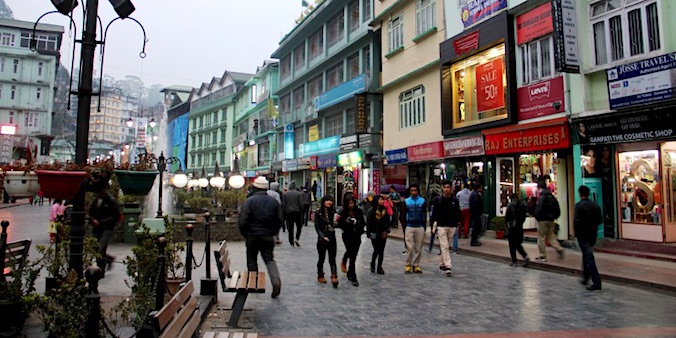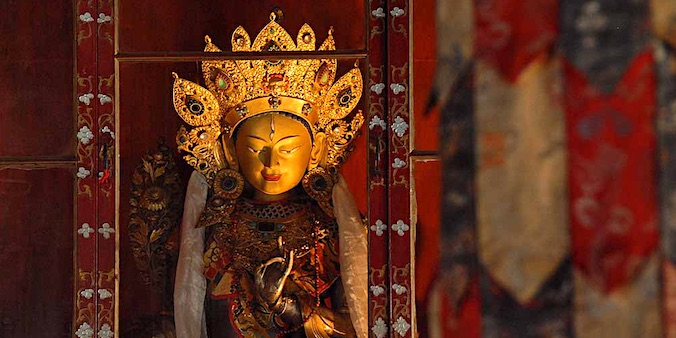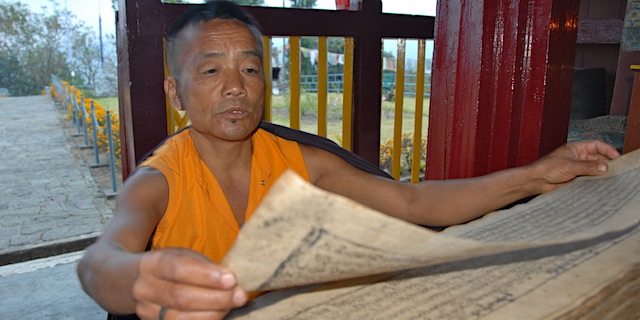Sikkim – Goecha La Trek
Tour - 12 days/ 8 days trekking
About Darjeeling & SIKKIM
Sikkim and neighboring Darjeeling have a lot to offer to mountain lovers, aficionados of Buddhist culture and trekkers. Wedged in between Nepal, Bhutan and Tibet but part of India – this region shares a lot with these areas.
Sikkim is a gem of cultural and natural diversity. Until 1974 it was an independent kingdom, now it is part of India. It is home to different Himalayan peoples, most from Nepali descent or originating from Tibetan and Bhutan, such as the Bhutias who brought Buddhism to the area four centuries ago. Thanks to them Sikkim boasts of colorful Buddhist monasteries and Buddhist festivals. The Lepcha’s, until a few decennia ago forest-dwelling animists, hold a unique culture that the Sikkimese government is trying to preserve.
Sikkim’s mountains range from 200 m to 8586 m and walkers and trekkers can choose from jungle treks or low altitude village treks, staying at home-stays, to high altitude treks that bring one up-close with some of the Himalayas’ highest peaks, like on this tour. Trekking, and other forms of eco-friendly tourism are strongly supported by the Sikkimese government, which has a track-record of measures and policies aimed at sustainable development
Region
Sikkim
(India)
Best Time
April-mid June &
Oct-Nov
No. Of Days
12 days, 8 days trek
Trip Character
Trekking tour
Sleeping Altitude
1650 - 4100 m
Trek Character
Camping trek
Level: 3
Price
INR XXX/ $ XXX
ABOUT THIS TOUR
On this tour you’ll be trekking close to the border between Sikkim (India) and Nepal, and up to the third highest mountain in the world, Mt. Kangchenjunga (8586 m). After exploring Sikkim’s pleasant and clean capital, Gangtok you’ll be taken to Yuksom, where the trek starts. In eight days you’ll traverse many altitude stages, from temperate forest to montane rododendron forests laden with lichens – and blooming spectacularly in springtime – to the high alpine meadows where the yaks and their herders roam. At Goecha La pass (4940 m) you’ll get awesome views of Mt. Kangchenjunga, the world’s third highest peak (8586 m/28169 ft).
This trek starts amidst lush green subtropical forests and villages surrounded by terraced fields of rice, wheat, maize, millet, and cardamom, and then traverses several altitudinal stages, including dense Rhododendron forests hat blossom profusely in spring, before ending at high-alpine yak meadows. Not only does it offer unparalleled views of the Himalayas’ giants, it also presents an overview of all the altitudinal stages that lie below this world of rocks and ice, and this in an area that is particularly well preserved.
YOUR custom-made TRIP
The tour described here, as well as the other ones on our website, are mainly meant as suggestions. We would be happy to offer you a travel proposal that fully meets your personal demands and expectations. That means that you choose where you want to go, what level of accommodation and type of transport you want and what activities you prefer.
Please let yourself be inspired by this and other trips on our website and then drop us a line (or call us) to explain your travel wishes. We will be happy to help you put together the perfect trip. You can reach us over e-mail, Messenger, Whatsapp or mobile phone.
EXTENSIONS & VARIATIONS
Apart from the tour as described here, you could consider the following add-ons and changes:
- Visit Darjeeling before the trek. Darjeeling was the former summer capital of British India and it has preserved much of the old-world charm, besides being world-famous for its tea and tea estates. Staying here a few days, at 2040m, will also add to your altitude acclimatisation.
- Travel further north – by car – into the Sikkimese Himalayas and explore the isolated ‘Tibetan’ hamlets of Lachung and Lachen.
ITINERARY
-
Day 1: Delhi ✈︎ Bagdogra - Gangtok (2 h flight, 4 -5 h drive)
The flight to Bagdogra takes less than 2 h and, in clear weather, offers wonderful views of the Himalayas, including Mt. Everest (8848m) and Kangchenjunga (8568m). At the airport our guide and driver await you, and take you to Gangtok, Sikkim’s quaint, but relatively hip capital. Altitude 135 → 1650m. -
Day 2: In Gangtok
Early morning, we can witness a spectacular sunrise over the Kanchenjunga massif from Tashi view point. Later on, we visit the famous Rumtek Monastery, not far from Gangtok. In the evening, we take a stroll on Mahatma Gandhi Marg, the heart of Gangtok city. Altitude 1650m -
Day 3: Gangtok - Yuksom (5 h)
After breakfast we drive to Yuksum, a historical town in West-Sikkim. Yuksom was established in 1642 as Sikkim’s first capital and the site of the first coronation. We’ll visit the Norbugang Throne and the small but interesting Dubdi Monastery. Altitude 1650m → 1780m. -
Day 4: Yuksom – Bakhim (4 - 6 h walking)
The first day of the trek takes us through dense vegetation and across two mountain streams with flowers such as magnolia, rhododendron, blue poppies and orchids. Wild life in this area includes black and brown Himalayan bear, barking deer and sambar deer. Today’s camp is at Bakhim, marked by a cluster of three small houses with fluttering Tibetan prayer flags. Altitude 1780 → 2120m. -
Day 5: Bakhim - Dzongri (6 -7h walking)
Today’s walk leads through heavily forested area and along the beautiful village of Tsoka, whose inhabitants are Tibetans engaged in producing cheese and growing vegetables. After a lunch stop at Phedang (3745m), a very steeply climb leads to Deorali and nearby Dzongri. Altitude 2720 → 4020m. -
Day 6: At Dzongri
Early morning we climb up to viewpoint to witness the dawn over the Kanchenjunga range. Rest of the day at leisure or exploring the surroundings. Altitude 4020m. -
Day 7: Dzongri – Thangsing (4 - 5 h walking)
Today, a gradual walk with occasional descents is followed by a steep descent to the Rangit River. After crossing this river by a bridge, there is a steep ascent through very thick rhododendron forest to the beautiful meadow of Thangsing. Very good views here of Mt. Pandim (6691m) and other peaks. Altitude 4020 → 3930m. -
Day 8: Thangsing - Lake Samiti - Lamume (3 h walking)
First half of the day's walk is steep and leads to beautiful and holy Lake Samiti, situated at the base camp of Mt. Pandim. Here you get very impressive views of the glaciers above. Camp is bit further in the meadows of Lamumi. Altitude 3930 → 4200m. -
Day 9: Trekking Lamume – Goecha La View Point – Thangsing (6-7 h walking)
Starting at pre-dawn we make the 2h climb to the 4940m high Goecha La viewpoint and are surrounded by magnificent peaks like Mt. Pandim, Kanchanjunga, Kabru, Talung and Guicha. The area beyond this view point is now a Conservation Zone for Snow Leopards and Blue Sheep and off-limits. We return to Thangsing. Altitude 4200 → 4600 → 3920m. -
Day 10: Trekking Thangsing – Bakhim (6–7 h walking)
The long descent initially leads through dense rhododendron forests and ends at the relatively ‘warm’ hamlet of Bakhim. From the camp, we look out on ridge after ridge of temperate forests and to the river far below. Nearby you can try the local millet beer. Altitude 3920 → 2750m. -
Day 11: Trekking Bakhim – Yuksom (5 h walking)
We descend all the way to the river, then enter a narrow valley through thick, semi-tropical forest, and follow the river. This involves several ascents and descents and crossings of tributaries. Wayside waterfalls provide plenty of opportunity for bathing! In Yuksom, we check in at a hotel. Altitude 2750 → 1750m. -
Day 12: Yuksum - Bagdogra ✈︎ Delhi (4 h drive, 2 h flight)
After breakfast you descend to Bagdogra where you check in for the flight to Delhi. It depends on the timing of your international flight whether you will need an overnight stay in Delhi. In the latter case we can arrange this for you.
HIGHLIGHTS OF THIS TOUR

Gangtok
Rumtek Monastery


Yuksum
THE BHUTIAS




